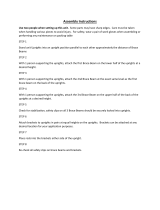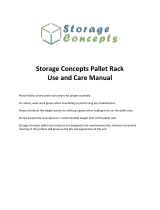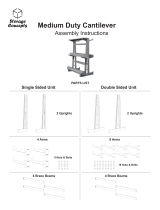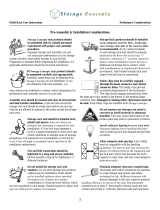Dexion DEEPSTOR DEIVE-IN PALLET RACKING User manual
- Category
- Motor vehicle electronics
- Type
- User manual

DEEPSTOR
DRIVE-IN PALLET RACKING
USER INSTRUCTIONS

BLANK

DEEPSTOR
DRIVE-IN PALLET RACKING
USER INSTRUCTIONS
This manual remains the sole property of Dexion (Australia) Pty Limited. It must not be copied
without prior written consent and must be returned upon request.
The information contained within this guide relates solely to the Dexion product, it doesn’t
necessarily relate to other similar systems available from alternative sources and should
not be used as the basis for operating these alternatives
Whilst the utmost care is taken to ensure the accuracy of the data and design details shown within,
Dexion (Australia) Pty Limited cannot, under any circumstances, be held liable for any injuries,
expenses or loss which may, in any degree, be attributed to the use or adoption of such data and
design details.
© Copyright:
Dexion (Australia) Pty Limited
Tattersall Road
BLACKTOWN NSW 2148
Product Management
Tel: +61 2 9830 5000
Fax: +61 2 9830 5003
E-mail: [email protected]
Date of Issue: August 2003

Deepstor
User Instructions
ISSUE 1
AUGUST 2003 Page iv
MANUAL AMENDMENT REGISTER
DEEPSTOR USER INSTRUCTIONS
Issue /
Amendment
Date
Issued
Description Inserted
By
Issue 1 Aug 03 Original Issue.

Deepstor
User Instructions
ISSUE 1 Table of Contents
AUGUST 2003 Page v
TABLE OF CONTENTS
INTRODUCTION ...................................................................................................................1
OPERATOR TRAINING .............................................................................................................................. 1
INSTALLATION DATA SHEET ................................................................................................................... 2
GLOSSARY OF DEXION TERMINOLOGY................................................................................................. 4
THE PALLET .........................................................................................................................5
PALLET TYPE AND SIZE ........................................................................................................................... 5
IMPORTANT NOTES:................................................................................................................................. 5
LOAD ON THE PALLET.............................................................................................................................. 5
PALLET WEIGHT ....................................................................................................................................... 6
PALLET CONDITION.................................................................................................................................. 6
PALLET ILLUSTRATION ............................................................................................................................ 7
THE FORK LIFT TRUCK (FLT) ............................................................................................9
LIFT HEIGHT .............................................................................................................................................. 9
CORRECT FORK LENGTH ........................................................................................................................ 9
DRIVER TRAINING..................................................................................................................................... 9
DAMAGE TO STORAGE EQUIPMENT ...................................................................................................... 9
CARE AND ATTENTION ............................................................................................................................ 9
OPERATIONAL CLEARANCES.........................................................................................10
LOAD ON THE PALLET............................................................................................................................ 10
LOAD WITHIN THE LANE ........................................................................................................................ 10
LOAD BEARING ON THE PALLET RAIL.................................................................................................. 10
DELIVERY CLEARANCE.......................................................................................................................... 10
FLT CLEARANCE..................................................................................................................................... 11
LOADING / UNLOADING THE SYSTEM ...........................................................................12
PICKING UP THE PALLET ....................................................................................................................... 12
CORRECT LOADING/UNLOADING PROCEDURE/SEQUENCE............................................................. 12
APPROACHING AND ENTERING THE RACK......................................................................................... 13
UNACCEPTABLE PALLET HANDLING....................................................................................................13
NEVER WORK BENEATH STORED PALLETS........................................................................................ 13
LOADING THE SYSTEM .......................................................................................................................... 14
UNLOADING THE SYSTEM ..................................................................................................................... 15
SAFETY – NEVER WORK UNDER PALLETS.......................................................................................... 16
CLEANING THE INSTALLATION ............................................................................................................. 17
ROUTINE INSPECTION / MAINTENANCE........................................................................18
‘RACK SAFETY OFFICER’ / ‘REPORTING PROCEDURE’...................................................................... 18
COLOUR CODING FOR RISK IDENTIFICATION..................................................................................... 18
INSPECTION INTERVALS........................................................................................................................ 19
DAMAGE TO THE STORAGE EQUIPMENT .....................................................................20
INTRODUCTION....................................................................................................................................... 20
COMPONENT RECOGNITION................................................................................................................. 21
REPORT ALL DAMAGE ........................................................................................................................... 21
REPLACE DON’T REPAIR ....................................................................................................................... 21
DAMAGE INSPECTION - LOAD ARM AND SAFETY LOCK .................................................................... 22
DAMAGE INSPECTION – PALLET RAIL.................................................................................................. 23
DAMAGE INSPECTION – RAIL SPLICE & FIXING .................................................................................. 24
DAMAGE INSPECTION – TOP / BACK BRACING & FIXING................................................................... 25

Deepstor
User Instructions
ISSUE 1 Table of Contents
AUGUST 2003 Page vi
DAMAGE INSPECTION – FRAMES ......................................................................................................... 26
DAMAGE INSPECTION – RACK OUT-OF-PLUMB .................................................................................. 27
RISK ASSESSMENT...........................................................................................................28
GREEN RISK ............................................................................................................................................ 28
ORANGE RISK ......................................................................................................................................... 28
RED RISK ................................................................................................................................................. 28
DAMAGE ACTION PROCEDURE FLOWCHART ..................................................................................... 29
TYPICAL CAUSES OF DAMAGE ............................................................................................................. 30
PRECAUTIONS AGAINST DAMAGE ....................................................................................................... 30

Deepstor
User Instructions
ISSUE 1 User Instruction
AUGUST 2003 Page 1
INTRODUCTION
Deepstor is the product name for the Dexion drive-in pallet racking system.
The system comprises parallel rows of frames and individual uprights, interconnected in the left to
right direction with top ties, and in the front to back direction with pallet support rails. Top bracing,
back bracing, and frame bracing provide the structure with overall stability. The system has been
designed to handle timber pallets, and comprises a number of storage lanes, made up of pallet
rails, supported on arms, which are connected to the rack uprights.
The system is devised so that a forklift truck may enter the rack to deposit a pallet at the rear of the
storage lane. Subsequent pallets are then stored sequentially above and in front of the original
pallet, thus providing good density of storage within a given area. Pallets are retrieved sequentially
in reverse order with the truck entering the rack to access the pallets at the rear of the installation.
This is a “Last In, First Out” storage system. (LIFO)
These instructions describe the principals of the Deepstor pallet racking system, how to
safely operate the racking, damage recognition, inspection, maintenance, etc.
The guide does not go into the specifics of individual installations.
OPERATOR TRAINING
Dexion recommends that ALL personnel operating within a warehouse environment are trained in
safe working practises.
Part of the training given to fork lift truck drivers should include the correct use of the
Deepstor installation. This should include the recognition of pallet types, checks on suitability, and
the correct method of loading and unloading the racking.
These guidelines describe how to use the system safely and should form part of your training. A
copy of this document should be made available to all drivers.

Deepstor
User Instructions
ISSUE 1 User Instruction
AUGUST 2003 Page 2
INSTALLATION DATA SHEET
Your installation has been designed around a pallet with the following characteristics.
Client:
Date of Installation:
Dexion reference:
Block Ref. or Rack Area:
Pallet Type:
Pallet size: x mm.
Pallet handled on the: mm face.
Load size (left to right) mm.
Load size (front to back) mm.
Any load overhang must be even on both sides.
Pallet + Load Height: mm.
Pallet Load: Kg maximum.
FLT Widest Part mm
FLT Clearance mm

Deepstor
User Instructions
ISSUE 1 User Instruction
AUGUST 2003 Page 3
To ensure safe use of the storage equipment, the user must understand the following
points:
Use of the equipment
The installation must be used in accordance with the specification and the criteria used for the
design of the rack. The duty of the rack components will have been specifically selected to meet
the individual load requirements of each rack. It is important that these are not exceeded and that
the rack is not altered without consultation.
Installation
The storage equipment must be built in accordance with the specification, plans, and assembly
instructions.
Floor
The warehouse floor, which is the racking foundation, must be capable of withstanding the upright
loads and of receiving the baseplate floor fixings. It must have a suitable degree of surface level
tolerance and flatness.

Deepstor
User Instructions
ISSUE 1 User Instruction
AUGUST 2003 Page 4
GLOSSARY OF DEXION TERMINOLOGY
The following terms are referred to within this guide.
Rack/Block: The complete structure, in length, depth and height, consisting all lanes and
levels from the front of the rack to the back.
Lane: A proportion of the rack separated by support frames includes all levels in
the height.
Level: An individual storage level within a lane. Could be either at floor level or at
a raised level where the pallets are stored on pallet rails.
Pallet Rails: Horizontal supports either side of a lane to support pallets at raised levels.
Support Arms: Cantilever brackets that attach to the rack uprights to support the beam rail.
Bracing: Fitted within selected lanes at the top, rear and lane sides to provide the
structure with necessary stability.
Stop the truck: The expression “stop the truck” means that the drive is neutralised and the
brake is applied.
Drive slowly: The expression “drive slowly” means travelling at a speed not exceeding
2.5km/h.
FLT Fork Lift Truck
FLT Clearance: Clearance between Support Arm / Rail and the widest part of the forklift
truck (i.e. mast or driver cab).

Deepstor
User Instructions
ISSUE 1 User Instruction
AUGUST 2003 Page 5
THE PALLET
The following gives general information about the pallet.
PALLET TYPE AND SIZE
Your Deepstor rack will have been designed around a specific pallet style and dimensions, this will
be detailed within “The Installation Data Sheet” on page 2.
The most common and widely used industrial pallets have also been illustrated on the following
page to aid identification.
• The Australian Standard Pallet 1165 x 1165
• European Pallet: EUR 800 x 1200mm
• Industrial: IND (Fin-pallet) 1000 x 1200mm
• The (UK) GKN pallet 1000 x 1200mm
The Australian Standard pallet is a 2-way entry pallet, which is normally handled on either of the
two opposing sides where the end of the bearers are exposed (refer to the pallet illustration). The
other industrial / European pallets can be handled on either the long or short face, which make
them known as ‘four way entry’ pallets.
IMPORTANT NOTES:
1. The orientation of pallet is important. Note the direction of pallet entry and ensure
that pallet is supported by pallet rails on the sides parallel to the entry direction. That
is along the bearer length for the Australian Pallet and short sides for the other three
pallets.
2. Whichever pallet your installation has been designed for it is important that only the
correct pallet be entered into the installation. It is dangerous to mix or enter any
other pallet style or size other than those the system has been designed for.
LOAD ON THE PALLET
The stability of the load on the pallet is important. Ideally loads will be shrink-wrapped or banded in
preference to lose stacking. There should not be any loose wrapping or banding on the bottom of
the pallet. Interlocking of individual items is better than an un-structured placement.
Any load overhang (if permitted) should be even on both sides of the pallet.
Ideally loads should be perpendicular and not lean, however this is rarely practical and the
following deviation is acceptable:
Pallet height up to 2000mm: Max. 1% of the pallet height.
Pallet height between 2000 and 3000mm: Max. 20mm.

Deepstor
User Instructions
ISSUE 1 User Instruction
AUGUST 2003 Page 6
PALLET WEIGHT
The pallet weight is the combination of the ‘self weight’ of the timber pallet + ‘load’.
The load must be distributed across the whole area of the pallet to avoid any potential uneven
loading of the rack.
Do not enter pallets with weights that exceed the permitted limit as indicated on the Dexion
Load Signs.
PALLET CONDITION
Pallets must be in good condition, and free from damage. Pallets with loose or broken boards, or
protrusions should NOT to entered into the system.
It is important that the pallet can safely support itself (with load) when spanning between the beam
rails.
If the strength of the pallet is in question a simple test can be carried out by the customer; support
the pallet along its edge (as Deepstor does) a little off the ground and load with 25% overload for at
least 24 hours. If the pallet doe not deflect more than pallet span/100 after this time it can be
considered suitable. Note for the test,
the load should NOT be banded or shrink wrapped, and
consist of small items with suitable gaps in between to avoid any bridging affect.
PALLET LOAD STABILITY
The stability of the load on the pallet is important. Ideally loads will be shrink-wrapped or banded in
preference to lose stacking. There should not be any loose wrapping or banding on the bottom of
the pallet. Interlocking of individual items is better than an un-structured placement.
Ideally loads should be perpendicular and not lean, however this is rarely practical and the
following deviation is acceptable:
Pallet height up to 2000mm: Max. 1% of the pallet height.
Pallet height between 2000 and 3000mm: Max. 20mm.

Deepstor
User Instructions
ISSUE 1 User Instruction
AUGUST 2003 Page 7
PALLET ILLUSTRATION
Australian Chep Wooden Pallet
(1165x1165x145)
Pallet Self Weight: 40Kg
Timber: Hardwood.
The Australian standard pallet has a square base of 1165mm (W) x 1165mm (D) with a maximum
height (H) of 150mm. The minimum clear entry height between bearers is 90mm. The pallet is a 2-
way entry pallet.
Direction of travel

Deepstor
User Instructions
ISSUE 1 User Instruction
AUGUST 2003 Page 8

Deepstor
User Instructions
ISSUE 1 User Instruction
AUGUST 2003 Page 9
THE FORK LIFT TRUCK (FLT)
The fork lift truck must be of a suitable design and capacity, capable of lifting the loads to the
heights required. If there are any doubts regarding its capacity reference should be made to the
relevant manufacturer or supplier.
LIFT HEIGHT
The truck must be capable of lifting the pallet clear of the top storage level by at least 100mm.
CORRECT FORK LENGTH
The forks should be of sufficient length to support all the boards, but not extend beyond the pallet
(refer to right-hand side figure for correct fork length)
DRIVER TRAINING
All fork truck drivers should be suitably trained and licensed in the operation of the handling
equipment. Secondly they should trained in the use of this type of storage system and have a copy
of these guidelines available to them.
DAMAGE TO STORAGE EQUIPMENT
The USER is responsible for ensuring that the handling equipment is driven carefully at all times to
avoid any collision with or damage to the rack structure
CARE AND ATTENTION
The following sections of guidelines cover the use of the system, and how to load and unload the
racking.
Following these recommendations and procedures, i.e. pallet inspection, correct pallet placement,
and alignment will all help the efficiency and smooth operation of the system helping to prevent
problems.
Adversely, harsh treatment or abuse will soon lead to damage, and a reduction in system reliability
and performance, and in extreme cases render the structure unsafe.
For the benefit of the system and personnel “Prevention is better than cure”.

Deepstor
User Instructions
ISSUE 1 User Instruction
AUGUST 2003 Page 10
OPERATIONAL CLEARANCES
LOAD ON THE PALLET
The load should be stacked centrally on the pallet, and if overhang has been permitted within the
design, the overhang should be even on both sides of the pallet.
LOAD WITHIN THE LANE
The fork lift truck should deliver the pallet squarely and centrally within the storage lane.
LOAD BEARING ON THE PALLET RAIL
When the pallet has been lowered onto the pallet rails there must be a minimum of 20mm bearing
between pallet and rail.
DELIVERY CLEARANCE
The forklift truck should deliver the pallet clear of the pallet rail by approximately 20 – 25mm.

Deepstor
User Instructions
ISSUE 1 User Instruction
AUGUST 2003 Page 11
FLT CLEARANCE
To minimize unnecessary forces induced on the rack by a forklift truck during its operation, it is
essential that a minimum clearance of 75mm on either side of the widest part of the truck and
arm/rail projection be provided. Refer to Operational Clearances for illustration.

Deepstor
User Instructions
ISSUE 1 User Instruction
AUGUST 2003 Page 12
LOADING / UNLOADING THE SYSTEM
The warehouse should be adequately lit, to permit the safe use of forklift trucks and the handling of
pallets.
PICKING UP THE PALLET
The pallet must be picked up square to the forks, any misalignment of the pallet on the forks can’t
be corrected during the placement sequence and results in badly placed pallets within the system.
Misalignment also increases the effective size of the pallet leading to a reduction in operating
clearances.
CORRECT LOADING/UNLOADING PROCEDURE/SEQUENCE
The following pages detail the correct procedures for loading and unloading the racks and the safe
sequence for delivering and retrieving loads.

Deepstor
User Instructions
ISSUE 1 User Instruction
AUGUST 2003 Page 13
APPROACHING AND ENTERING THE RACK
The forklift truck should approach the rack squarely and not at an angle.
No attempt should be made to deposit/retrieve pallets or to enter a rack when the truck is NOT
correctly aligned. It is not acceptable to attempt to re-align a truck after entry into the rack.
UNACCEPTABLE PALLET HANDLING
It is not acceptable practice to:
• Nudge one pallet with another, in an attempt to move or re-align loads.
• Drag or slide pallets on or against the pallet rails or structure.
• Position or locate a pallet by nudging the one behind.
All of these are dangerous practices that impart additional loads in the rack structure, and could
lead to damage and a reduction in safety.
All are avoidable if the correct procedures are adopted.
NEVER WORK BENEATH STORED PALLETS
It is not safe to either work or drive a truck beneath a pallet that is being stored above.
Adhering to the correct loading/unloading sequences will prevent these unsafe situations occurring.

Deepstor
User Instructions
ISSUE 1 User Instruction
AUGUST 2003 Page 14
LOADING THE SYSTEM
Step 1 Check that the pallet is the correct style and size for the installation.
Step 2 Check the underside of the pallet for loose, split or damaged boards.
Damaged pallets should not be entered into the racking.
Step 3 The fork lift truck driver inserts the forks into the pallet, and picks the pallet
up ensuring that it is square and that the forks are evenly spaced within the
pallet. Any skew in the pallet at this stage cannot be corrected and will
remain when the pallet is placed in the rack.
Step 4 The fork lift truck drives with the pallet, and approaches the rack squarely
aligning itself centrally with the desired storage lane.
Step 5 Slow down and stop the truck at the entrance to the lane. Reduce any tilt
on the mast and raise the pallet to the required storage level ensuring the
pallet is still central between the pallet rails.
Step 6 Drive slowly into the storage lane towards the intended storage location,
keeping the pallet and truck mast clear of contact with the pallet rails or any
other part of the rack structure.
Step 7 Stop the truck before making contact with previously positioned pallets.
Step 8 Carefully lower the pallet onto the pallet rails, ensuring no contact with the
sides of the pallet rail or the pallet behind. There should be a minimum
20mm bearing on the beam rail.
Step 9 When the pallet is securely positioned lower the forks until they are free
from the pallet and reverse the truck carefully out of the storage lane,
checking the aisle is clear.
Step 10 When clear of the rack lower the forks to just above ground level before
driving off.
Follow the above stacking sequence to avoid potential access beneath stored pallets.
Page is loading ...
Page is loading ...
Page is loading ...
Page is loading ...
Page is loading ...
Page is loading ...
Page is loading ...
Page is loading ...
Page is loading ...
Page is loading ...
Page is loading ...
Page is loading ...
Page is loading ...
Page is loading ...
Page is loading ...
Page is loading ...
Page is loading ...
-
 1
1
-
 2
2
-
 3
3
-
 4
4
-
 5
5
-
 6
6
-
 7
7
-
 8
8
-
 9
9
-
 10
10
-
 11
11
-
 12
12
-
 13
13
-
 14
14
-
 15
15
-
 16
16
-
 17
17
-
 18
18
-
 19
19
-
 20
20
-
 21
21
-
 22
22
-
 23
23
-
 24
24
-
 25
25
-
 26
26
-
 27
27
-
 28
28
-
 29
29
-
 30
30
-
 31
31
-
 32
32
-
 33
33
-
 34
34
-
 35
35
-
 36
36
-
 37
37
Dexion DEEPSTOR DEIVE-IN PALLET RACKING User manual
- Category
- Motor vehicle electronics
- Type
- User manual
Ask a question and I''ll find the answer in the document
Finding information in a document is now easier with AI
Other documents
-
Pacific Entries M55ML6 Installation guide
-
 Storage Concepts 215-FRS3618036 Operating instructions
Storage Concepts 215-FRS3618036 Operating instructions
-
 Storage Concepts HL40108M-42144 User manual
Storage Concepts HL40108M-42144 User manual
-
 Storage Concepts HSS72-12 Operating instructions
Storage Concepts HSS72-12 Operating instructions
-
Crown SC 6000 Operating instructions
-
Crown TSP 7000 Operating instructions
-
 Storage Concepts HL40108M-42144 Operating instructions
Storage Concepts HL40108M-42144 Operating instructions
-
Vestil EPT Owner's manual
-
Crown C-5 Pneumatic Tire Operating instructions
-
Intel SGI Altix 450 User manual








































